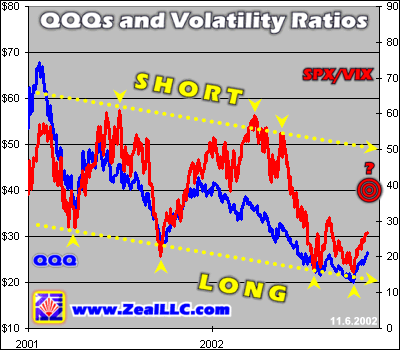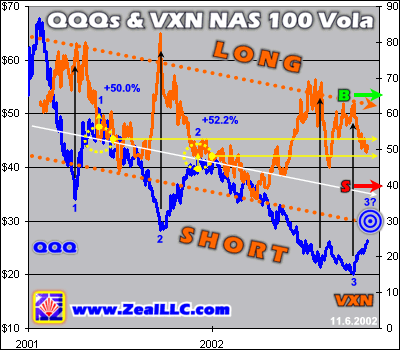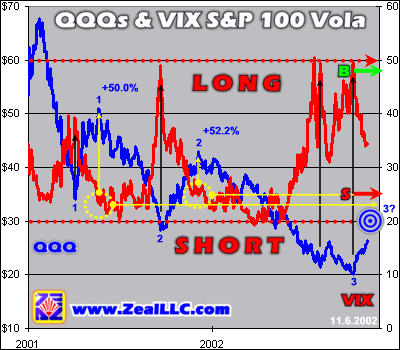|
|
|||||||
|
|
|
|
|
|
|
|
|
|
Volatility Trading the QQQs 2 Adam Hamilton November 8, 2002 2830 Words
What an amazing week for stock-index speculators!
It all began after the closing bell last Friday afternoon, when the US government declared that it was probably done harassing Microsoft. Minutes later an announcement hit the wires indicating the problem-plagued West Coast longshoremen had reached an agreement to increase their efficiency for offloading containers from ocean-going freighters. With these two scrumptious morsels of positive news to digest, how could the markets not rally on Monday?
And so it was! Before the stock markets even opened for business Monday morning, futures traders had ramped up equity-index futures in anticipation of a rally. After a strong opening the morning rally faded a bit as the quick-on-the-draw speculators pocketed healthy profits on the surprise tidings.
Then Tuesday rolled around, Election Day. The Republicans, who at least give lip service to the crucial principles of smaller government and lower taxes, swept the mid-term elections. Their surprise victory and the defeat of the taxation-and-welfare-happy Democrats boded well for market sentiment.
The information avalanche continued unabated on Wednesday, when Alan Greenspan and his Communist-style Central Planning Committee decided to once again, behind closed doors, brazenly manipulate the short-term interest rates in America. A huge 50 basis-point cut off a low 175bp base, effectively slashing overnight rates 29%, was probably the biggest single-move absolute-percentage rate cut in the Fed’s entire disastrous 89-year history.
As anticipated 4 weeks ago in “Forcing the Fed’s Hand”, bond traders had backed the Fed into a corner and forced it to act by aggressively bidding up short bond prices and pressuring down short yields. The command-and-control Fed, as usual, was just playing catch-up with the free markets.
With all these major developments to consider, the first week of November 2002 proved very exciting for speculators! Following this intense whirlwind of equity-positive strategic news however, growing uncertainty abounds over what to expect next in terms of short-term stock-index gyrations.
This week at Zeal we forged ahead in various volatility studies that we have been using to execute our own actual real-time index speculations. As discussed extensively in recent Zeal Intelligence newsletters and essays, we prefer options trading with the hyper-popular QQQs as our stock-index speculations of choice at this peculiar moment in history. This elite NASDAQ 100 tracking stock has become the most-traded speculation vehicle on Earth which provides instant liquidity and endless opportunities to profit.
Like most speculators this week, we too focused on the all-consuming question of the hour. Is the current bear-market rally exhausted? Are we doomed to plunge back down now on rampant equity overvaluations? Or will bullish sentiment seize the day and drag the equity indices and cubes (QQQs) even higher for a few more weeks? Inquiring speculators want to know!
We rolled up our sleeves, plunged into the endless blizzard of raw data, and updated about a half dozen graphs we have been zealously following. The three most interesting ones, all updates of graphs explained in depth in past Zeal essays, are presented below.
Our first graph this week is an update of Dan Basch’s SPX/VIX ratio analyzed in depth in “Trading Volatility Ratios” 5 weeks ago. Since that essay was published, we have received a myriad of inquiries from around the globe seeking information on how the ratio has been behaving since the magnificent bear-rally bounce off the recent October 9th interim lows.
For a quick review, the SPX/VIX ratio is calculated by dividing the S&P 500 close (symbol SPX) by the VIX close (the S&P 100 Implied Volatility Index). On November 6th the S&P 500 closed at 924 and the VIX finished the session at 34, yielding an SPX/VIX ratio of 27.
The SPX/VIX ratio throws off short-term buy signals when it nears the bottom support line of its trend, indicating a potentially profitable time to buy QQQ calls and sell QQQ puts. Conversely, when the ratio travels up near its top resistance line, a profitable time to sell QQQ calls and buy QQQ puts has probably arrived. As is evident in the graph above, the SPX/VIX has been a reliable short-term speculation tool in the ongoing Great Bear bust.
Last time we examined this data there was a growing divergence between the SPX/VIX ratio trend (up) and the QQQs (down) since the July 23rd bear-market bounce. On October 4th I mentioned that the divergence needed to close suggesting that a massive NASDAQ bear-market rally was imminent. Thankfully since that day the anticipated bear-market rally did indeed materialize, netting large speculative profits for those fearless contrarian speculators who pre-deployed capital in anticipation of the move.
While the SPX/VIX ratio was super-bullish 5 weeks ago, now it is merely mildly bullish or even approaching the neutrality zone. The massive QQQ rally since the latest October 9th bounce is quite evident above, a major move by anyone’s standards. The positive divergence between the SPX/VIX ratio and the cubes was closed as the powerful NASDAQ rally bridged the technical rift.
Unfortunately Basch’s ratio is no longer throwing out any strong buy signals at the moment, suggesting no fresh longs should be deployed. The SPX/VIX ratio will probably run higher before this bear-market rally ends, but the key question is how high? Using the S&P 500 potential rally targets we discussed in the new November issue of Zeal Intelligence for our subscribers, a reasonable analytical guess can be advanced.
If the S&P 500 is able to rally up to its 965 target explained in the newsletter, and the VIX descends to 25 throwing out a stellar signal to go short again with a vengeance, the SPX/VIX ratio could approach 40 this time around. This potential ratio target is marked in the graph above with a bull’s-eye. Only time will tell whether this target will prove to be reasonably accurate or merely a flight of fancy.
While no mere mortal can see the future, far superior trades can be executed if a speculator has some idea of where the markets may be heading in the coming weeks. With finite time and energy to devote to studying the markets, it is probably not a wise idea to plow too many resources into trying to divine an exact SPX/VIX ratio top.
While the ratio throws out magnificent long buy signals at fear extremes, its short-signal record is nowhere near as ideal. Notice in the graph above how the ratio always peaked weeks or months after its preceding bear-market rally topped. While a wonderful tool, the time the SPX/VIX ratio really shines is at major bear-rally bounce points, not tops.
Since we just emerged from two of these bounce points, we are now diligently searching the chaotic market horizons for clues on shorting timing. While we will certainly resurrect analysis of this ratio again sometime in 2003 when another major bear-market bounce appears to be looming, our short-signal search will probably yield superior fruits elsewhere.
Our next two graphs for QQQ speculators to consider are both updates from the original “Volatility Trading the QQQs” essay of 8 weeks ago. The first compares the cubes to the VXN NASDAQ 100 Implied Volatility Index. Unlike the SPX/VIX ratio, this technical tool offers more concrete insights on specific timing to close longs and deploy short plays in anticipation of the next major supercycle bear-market downleg.
In review, the VXN (pronounced “Vixen”), unlike the SPX/VIX ratio, is a contra-indicator for speculators. The time to go long the QQQs, sell puts, and buy calls is when the VXN is very high, scraping its top resistance line. Conversely, the time to throw short, sell calls, and buy puts is when the VXN falls back towards its lower support line.
The last 8 weeks of trading have offered new and valuable insights on the behavior of the upstart VXN index. Since then its trend has grown clearer, with a definite downtrend pipe emerging out of the murky mists of time. Its potential trendlines are marked above in orange, although caution should be exercised as the VXN is too young to place heavy reliance on its activity yet.
Nevertheless, as both the tops and bottoms in the VXN are roughly bouncing within its downtrend pipe, we lowered our target VXN long signal from 75 to 65 or so. As the black arrows above indicate, each VXN spike flirting with this overhead resistance line turned out to be an excellent short-term buy signal for the QQQs.
The VXN levels at the tops of the last two massive bear-market rallies in recent years are marked by the yellow circles above. Because we were making the assumption the VXN would trade in a horizontal range like its mentor the venerable VIX, its sell-signal level seemed ambiguous in our analysis of 8 weeks ago. At the time we defined a hypothetical VXN sell signal around 40, but with much uncertainty.
Today, with the benefit of the VXN downtrend perspective, VXN 40 still seems like a sensible sell signal. Provocatively, a parallel downtrend midline drawn through the two recent VXN shorting points, the white arrow above, points to a potential current VXN sell signal of right under 40.
Even though the VXN is currently trading around 50, the range at which the previous two mighty NASDAQ bear-market rallies topped, today the charts look like the VXN could plunge below 40 before a major shorting signal is flagged. While we have absolutely no way of knowing if the VXN downtrend channel will hold into the future, it seems reasonable to give it the benefit of the doubt for now.
If the VXN downtrend does fail, odds are it will fail to the upside spiking to a high extreme on a new bear-market interim low sometime in 2003. Until VXN 40 is breached in the coming weeks, this NASDAQ 100 volatility index remains neutral, neither calling for fresh longs nor signaling the opportune moment to deploy fresh shorts.
One of the most important aspects of the Great Game of Speculation is patience, zealously stalking a potential trade and waiting until the ideal moment to strike with a fresh speculation. With the VXN bleeding down from extremes but still around 50, it has not yet launched its flare to signal the time to short is once again nigh. While it is certainly challenging being patient and waiting for the markets, the mastery of the art of patience often separates the great traders from the merely average traders.
Interestingly, even the QQQs themselves look like they could technically have a little bit farther to run in the coming weeks. The last two major bear-market rallies, numbered in the graph above, propelled the QQQs to massive 50% and 52% gains. By deploying QQQ options these enormous underlying QQQ moves could be multiplied many times over to yield truly magnificent profits for short-term speculators brave or foolish enough to trade against the primary bearish downtrend.
Considering this average 51% QQQ gain in the last two major bear rallies, +50% this time around could prove to be a pivotal milestone again in the cubes. Since they last bounced on October 9th at $20, a similar gain today would yield a bear-rally termination target of $30 or so. This target is marked above with the blue bull’s-eye.
On November 6th the cubes closed at $26.47, already soaring up 32% off their October lows. This means, if the averages hold, that our current bear-market rally may already be 2/3 over. Buying the QQQs at $20 and selling at $26.47 would yield an impressive 32% gain. But buying the QQQs today at $26.47 and holding out for $30 is a very dangerous game, with potential rewards of only 13%.
If you didn’t already have capital pre-deployed in anticipation of this bear-market rally as our Zeal Intelligence subscribers did, there is no sense chasing it now as it nears the end of its projected lifespan. Going long today is a super-risky bet with prospects of an incongruously low reward, a bad idea!
Our final graph showcases the venerable VIX, still my personal favorite short-term speculation tool. While a lot of folks out there are advancing all kinds of theories suggesting the VIX will explode to hyper-extremes, speculators who have been trading the VIX thus far in the bust have earned a gargantuan king’s ransom in speculative profits. I have yet to see a convincing argument why this streak shouldn’t continue for another bear-rally cycle.
The wonderful thing about the S&P 100 Implied Volatility Index, or VIX (pronounced “Vicks”), is its established track record. A VIX spike to 50 is high today, was high after 9/11 in 2001, and was high in the infamous 1998 financial crises. The VIX has traded in a perfect horizontal trend since 1997, with VIX 50 always representing frightening extremes of general fear marking short-term market bounce points for launching major tradable rallies.
As discussed in the first iteration of this essay, the VIX is also a contra-indicator for speculators. When it soars to extremes near 50, fear is too high and a short-term market rally is imminent. VIX 50 marks the perfect moment to go long, sell puts, and buy calls. Conversely a lower VIX, around 25 (see the yellow circles above), has marked short-term bear-rally tops in recent years. When VIX 25 is achieved, the time to go short, sell calls, and buy puts has arrived.
While the VIX is not magical or infallible and there is no guarantee the indicator will continue to work in the future as it has in the past, it remains one of the most reliable short-term technical trading tools in existence today. Speculators only ignore its signals at great peril to their own scarce capital. Like the Rock of Gibraltar of the speculative world, the message of the VIX hasn’t changed at all in the last 8 weeks.
The VIX spike to 50 on July 23rd didn’t mark the true bounce point, as I erred in expecting at the time. Perhaps because it happened during normally low-volume late-summer trading, perhaps because everyone was concerned about terrorist attacks on the first anniversary of 9/11, the ensuing bear-rally fizzled early. Nevertheless, it was still tradable.
Then the VIX once again rocketed up, closing at 49 on October 9th and signaling our latest interim bottom. As mentioned above, the QQQs closed at $20 that day and have accelerated northwards like a rocket ever since.
Interestingly, whether you went long at the first VIX 50 spike or the second VIX 49 spike, you still had the opportunity to earn big profits holding until today either way. While the recent VIX double top was as ugly as the drawn-out 1998 episode, it didn’t negate the powerful short-term buy signal of the venerable VIX.
As the VIX continues to fall towards its 25 technical-congestion level today, its strong sell signal could potentially be flashed at the QQQ $30 level. While by no means a certain prospect, the VIX showing its sell signal to speculators at the QQQ $30 50% rally level where the last two great bear-market rallies have failed would provide an enormous incentive to go short, sell calls, and buy puts in anticipation of the next great downleg. The shorting profit prospects are dazzling!
If you were fortunate enough to have longs deployed in advance in anticipation of this current bear rally as our Zeal Intelligence subscribers did, you can probably still hold on to your long positions for higher exit points in another few weeks. However if you do have outstanding longs and you are already losing sleep, don’t feel bad about selling now and pocketing your large call-options profits today.
But if you don’t already have any longs deployed now, it makes little sense to go long today when most of the bear rally is likely behind us. It’s probably best to wait for The Big Trade, put-optioning the heck out of the next major downleg in this brutal ongoing supercycle NASDAQ bust.
If you are an active short-term speculator and this type of information interests you, please consider subscribing to our newsletter. Every month we monitor the indices and potential long and short signals and recommend specific options trades based on our research. The November 2002 issue of Zeal Intelligence just published outlines even more technical indicators we are eagerly watching for the short signal for The Big Trade, as well as potential bear-rally target levels for the major equity indices.
If you subscribe today to the electronic PDF version of Zeal Intelligence, we will promptly e-mail you out a complimentary copy of the current November issue. Your paid subscription won’t start until the next new issue due out in early December.
As the potential index-options trading profits in this turbulent market epoch could run literally thousands of times the modest price of admission, please consider granting us the opportunity to serve you.
While this recent bear-market rally was fun for those who anticipated it, the short-side profits in the coming US equity downleg as the Great Bear bust continues have the potential to be truly legendary!
Adam Hamilton, CPA November 8, 2002 Subscribe |
|||||||
|
|
|
|
|
|
|
|
|
|
|
|
|
|
|
|||



